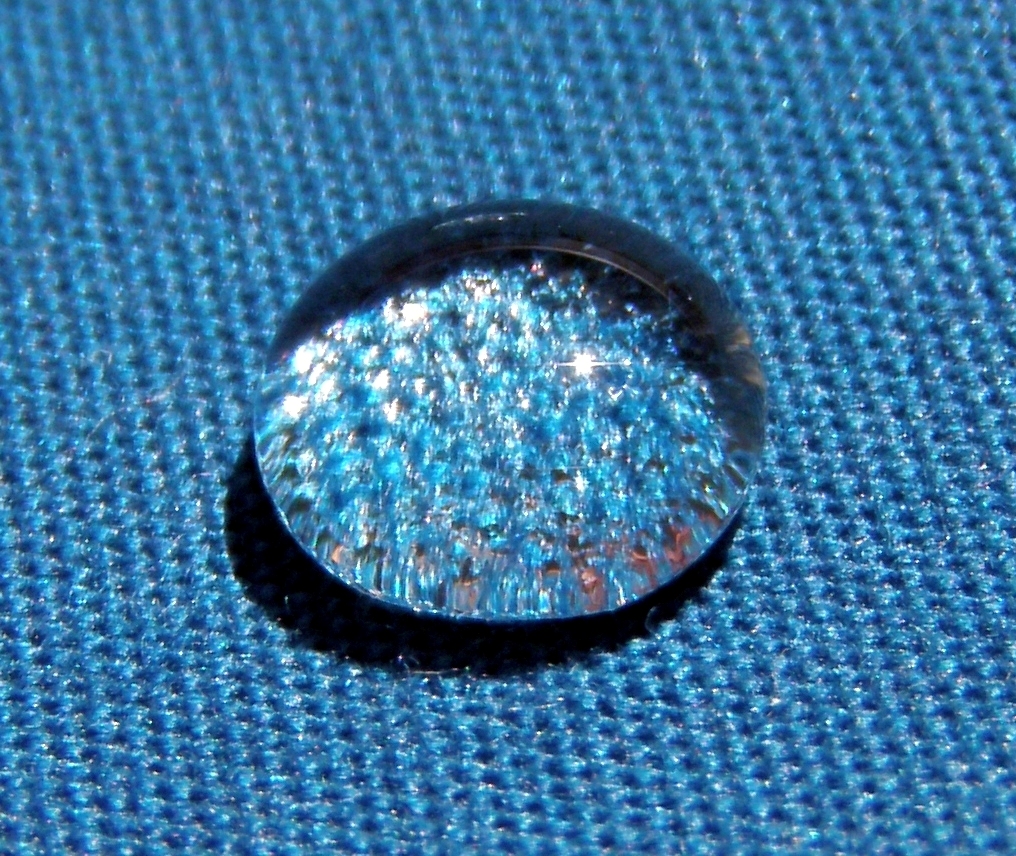|
Gore-Tex
Gore-Tex is W. L. Gore & Associates's trade name for waterproof, breathable fabric membrane. It was invented in 1969. Gore-Tex blocks liquid water while allowing water vapor to pass through and is designed to be a lightweight, waterproof fabric for all-weather use. It is composed of expanded PTFE (ePTFE), a stretched out form of the PFAS compound polytetrafluoroethylene (PTFE). History Gore-Tex was co-invented by Wilbert L. Gore and Gore's son, Robert W. Gore. In 1969, Robert (Bob) Gore stretched heated rods of polytetrafluoroethylene (PTFE) and created expanded polytetrafluoroethylene (ePTFE). His discovery of the right conditions for stretching PTFE was happy accident born partly of frustration. Instead of slowly stretching the heated material, he applied a sudden, accelerating yank. The solid PTFE unexpectedly stretched about 800%, forming a microporous structure that was about 70% air. It was introduced to the public under the trademark Gore-Tex. Gore promptly applied ... [...More Info...] [...Related Items...] OR: [Wikipedia] [Google] [Baidu] [Amazon] |
EPTFE
Polytetrafluoroethylene (PTFE) is a synthetic fluoropolymer of tetrafluoroethylene, and has numerous applications because it is chemically inert. The commonly known brand name of PTFE-based composition is Teflon by Chemours, a spin-off from DuPont, which originally invented the compound in 1938. Polytetrafluoroethylene is a fluorocarbon solid, as it is a high- molecular-weight polymer consisting wholly of carbon and fluorine. PTFE is hydrophobic: neither water nor water-containing substances wet PTFE, as fluorocarbons exhibit only small London dispersion forces due to the low electric polarizability of fluorine. PTFE has one of the lowest coefficients of friction of any solid. Polytetrafluoroethylene is used as a non-stick coating for pans and other cookware. It is non-reactive, partly because of the strength of carbon–fluorine bonds, so it is often used in containers and pipework for reactive and corrosive chemicals. When used as a lubricant, PTFE reduces friction, w ... [...More Info...] [...Related Items...] OR: [Wikipedia] [Google] [Baidu] [Amazon] |
Bill Gore
Wilbert Lee "Bill" Gore (January 25, 1912 – July 26, 1986) was an American engineer and scientist, inventor and businessman who co-founded W. L. Gore and Associates with his wife, Genevieve (Vieve). Trained as a chemical engineer and chemist, his technical interests included polymer engineering, applications of statistical methods to experimentation, and methods of operations research. He held patents in the fields of plastics, fluorocarbons, and electronics. He was also an active outdoorsman. Biographical information Born in Meridian, Idaho in 1912, Bill Gore held degrees in chemical engineering (B.S., 1933) and physical chemistry (M.S., 1935) from the University of Utah. His early career included employment at American Smelting and Refining Company, Remington Arms, and the DuPont Company. In 1957, Gore left a career with DuPont to pursue an idea of his own for making electronic ribbon cable for use in computers that was insulated with polytetrafluoroethylene (PTFE).Resume ... [...More Info...] [...Related Items...] OR: [Wikipedia] [Google] [Baidu] [Amazon] |
Waterproof Fabric
Waterproof fabrics are fabrics that are, inherently, or have been treated to become, resistant to penetration by water and wetting. The term "waterproof" refers to conformance to a governing specification and specific conditions of a laboratory test method. They are usually natural or synthetic fabrics that are laminated or coated with a waterproofing material such as wax, rubber, polyvinyl chloride (PVC), polyurethane (PU), silicone elastomer, or fluoropolymers. Treatment could be either of the fabric during manufacture or of completed products after manufacture, for instance by a waterproofing spray. Examples include the rubberized fabric used in Mackintosh jackets, sauna suits, and inflatable boats. Definition and specifications Waterproof/breathable fabrics resist liquid water passing through, but allow water vapour to pass through. Their ability to block out rain and snow while allowing vapour from sweat to evaporate leads to their use in rainwear, waterproof outdoor sp ... [...More Info...] [...Related Items...] OR: [Wikipedia] [Google] [Baidu] [Amazon] |
Perfluorooctanoic Acid
Perfluorooctanoic acid (PFOA; conjugate acid, conjugate base perfluorooctanoate; also known colloquially as C8, from its chemical formula C8HF15O2) is a perfluorinated carboxylic acid produced and used worldwide as an industrial surfactant in chemical processes and as a chemical precursor. PFOA is considered a surfactant, or fluorosurfactant, due to its chemical structure, which consists of a perfluorinated, ''n''-heptyl "tail group" and a carboxylic acid "head group". The head group can be described as hydrophilic while the fluorocarbon tail is both hydrophobic and lipophobic. The International Agency for Research on Cancer (IARC) has classified PFOA as carcinogenic to humans. PFOA is one of many synthetic organofluorine compounds collectively known as per- and polyfluoroalkyl substances (PFASs). Many PFAS such as Perfluorooctanesulfonic acid, PFOS, PFOA are a concern because they do not break down via natural processes and are commonly described as persistent organic pollutants ... [...More Info...] [...Related Items...] OR: [Wikipedia] [Google] [Baidu] [Amazon] |
Fluorosurfactant
Per- and polyfluoroalkyl substances (also PFAS, PFASs, and informally referred to as "forever chemicals") are a group of synthetic Organofluorine chemistry, organofluorine chemical compounds that have multiple fluorine atoms attached to an alkyl chain; there are 7 million known such chemicals according to PubChem. PFAS came into use with the invention of Teflon in 1938 to make fluoropolymer coatings and products that resist heat, oil, stains, grease, and water. They are now used in products including waterproof fabric such as Nylon, yoga pants, carpets, shampoo, feminine hygiene products, mobile phone screens, wall paint, furniture, adhesives, food packaging, firefighting foam, and the insulation of electrical wire. PFAS are also used by the cosmetic industry in most cosmetics and personal care products, including lipstick, eye liner, mascara, foundation (cosmetics), foundation, concealer, lip balm, blush (cosmetics), blush, and nail polish. Many PFAS such as Perfluorooctanesulfo ... [...More Info...] [...Related Items...] OR: [Wikipedia] [Google] [Baidu] [Amazon] |
Forever Chemical
Per- and polyfluoroalkyl substances (also PFAS, PFASs, and informally referred to as "forever chemicals") are a group of synthetic organofluorine chemical compounds that have multiple fluorine atoms attached to an alkyl chain; there are 7 million known such chemicals according to PubChem. PFAS came into use with the invention of Teflon in 1938 to make fluoropolymer coatings and products that resist heat, oil, stains, grease, and water. They are now used in products including waterproof fabric such as Nylon, yoga pants, carpets, shampoo, feminine hygiene products, mobile phone screens, wall paint, furniture, adhesives, food packaging, firefighting foam, and the insulation of electrical wire. PFAS are also used by the cosmetic industry in most cosmetics and personal care products, including lipstick, eye liner, mascara, foundation, concealer, lip balm, blush, and nail polish. Many PFAS such as PFOS and PFOA pose health and environmental concerns because they are persistent organi ... [...More Info...] [...Related Items...] OR: [Wikipedia] [Google] [Baidu] [Amazon] |
Per- And Polyfluoroalkyl Substances
Per- and polyfluoroalkyl substances (also PFAS, PFASs, and informally referred to as "forever chemicals") are a group of synthetic organofluorine chemical compounds that have multiple fluorine atoms attached to an alkyl chain; there are 7 million known such chemicals according to PubChem. PFAS came into use with the invention of Teflon in 1938 to make fluoropolymer coatings and products that resist heat, oil, stains, grease, and water. They are now used in products including waterproof fabric such as Nylon, yoga pants, carpets, shampoo, feminine hygiene products, mobile phone screens, wall paint, furniture, adhesives, food packaging, firefighting foam, and the insulation of electrical wire. PFAS are also used by the cosmetic industry in most cosmetics and personal care products, including lipstick, eye liner, mascara, foundation, concealer, lip balm, blush, and nail polish. Many PFAS such as PFOS and PFOA pose health and environmental concerns because they are persi ... [...More Info...] [...Related Items...] OR: [Wikipedia] [Google] [Baidu] [Amazon] |
Expanded Polyethylene
Expanded polyethylene (EPE foam) refers to foams made from polyethylene. Typically it is made from expanded pellets ('EPE bead') made with use of a blowing agent, followed by expansion into a mold in a steam chest - the process is similar to that used to make expanded polystyrene foam. Properties EPE foams are low density, semi-rigid, closed cell foam that are generally somewhere in stiffness/compliance between Expanded polystyrene and Polyurethane. Production of EPE foams is similar to that of expanded polystyrene, but starting with PE beads. Typical densities are with the lower figure being common. Densities as low as can be produced. Base polymer for EPE foams range from Low-density polyethylene (LDPE) to High-density polyethylene (HDPE). Co-polymers Expanded polyethylene copolymers (EPC) are also known - such as 50:50 (weight) materials with polystyrene. Though other properties are intermediate between the two bases, toughness for the copolymer exceeds either, with good te ... [...More Info...] [...Related Items...] OR: [Wikipedia] [Google] [Baidu] [Amazon] |
Garlock Sealing Technologies
Garlock Sealing Technologies is a subsidiary of Enpro Company that produces sealing products. Garlock has a global presence, with 1,887 employees, at 14 facilities, in twelve countries. History In the later nineteenth century, Olin J. Garlock devised a better way to seal piston rods in industrial steam engines. The invention led to the creation of Garlock Sealing Technologies. Founded in 1887, in Palmyra, New York. For a detailed history of Garlock from its founding in 1887 until the takeover by Colt Industries in 1976, see ''Garlock - The First Eighty-Eight Years 1887-1975,'' written by Robert M. Waples and son. (Waples was President then Chairman 1955-1960) Industries Garlock provides fluid sealing solutions for the following industries: petrochemical, chemical processing, and refining, pulp and paper, power generation, electronics, steel mills, food and pharmaceutical, mining and original equipment manufacturers. Patented products Some of Garlock's sealing products include ... [...More Info...] [...Related Items...] OR: [Wikipedia] [Google] [Baidu] [Amazon] |
Durable Water Repellent
Durable water repellent, or DWR, is a coating added to fabrics at the factory to make them water-resistant (''hydrophobic''). Most factory-applied treatments are fluoropolymer based; these applications are quite thin and not always effective. Durable water repellents are commonly used in conjunction with waterproof breathable fabrics such as Gore-Tex to prevent the outer layer of fabric from becoming saturated with water. This saturation, called 'wetting out,' can reduce the garment's breathability (moisture transport through the breathable membrane) and let water through. As the DWR wears off over time, re-treatment is recommended when necessary. Many spray-on and wash-in products for treatment of non-waterproof garments and re-treatment of proofed garments losing their water-repellency are available. Methods for factory application of DWR treatments involve applying a solution of a chemical onto the surface of the fabric by spraying or dipping, or chemical vapor deposition (C ... [...More Info...] [...Related Items...] OR: [Wikipedia] [Google] [Baidu] [Amazon] |







